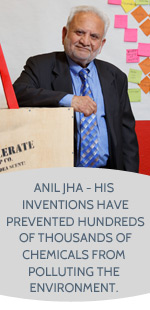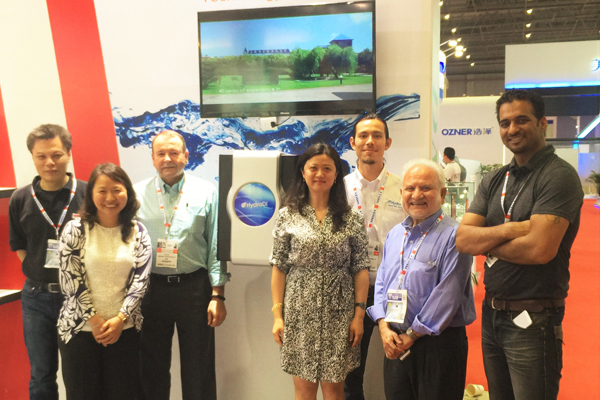 How Patents Helped a “Water Technology Visionary” to Follow His Dream
How Patents Helped a “Water Technology Visionary” to Follow His Dream
When Anil Jha arrived in America from Indore, India at age 16, he could hardly have imagined that he would one day become an inventor and transform the water treatment industry. After landing in New York City for a short time, Mr. Jha traveled to Boston, Massachusetts, where he attended Wentworth Institute of Technology to acquire the practical skills he was lacking. “Before then I’d never even held a screwdriver in my hand,” explains Mr. Jha. At Wentworth, he gained the confidence he needed to enter the U.S. workforce, and after obtaining a degree in material science, Mr. Jha began working as an R&D technician at Cabot Corporation while attending the University of Massachusetts at night.
Soon, he secured a job as a technician at water treatment company Ionics Inc., where he obtained some of his first patents, and later moved to Millipore Corporation. There, along with two of his colleagues (including Gary Ganzi, a member of the IPO Board of Directors), he developed electrodeionization—an innovation for which he has been dubbed a “water technology visionary,” and which he says has prevented the discharge of hundreds of thousands of chemicals into the environment.
Simply put, electrodeionization is a method of purifying water using electricity. Traditional methods of water treatment require periodic treatment by chemicals and salts, which regenerate the water purification instruments through which the water flows. Unfortunately, those chemicals and salts are often disposed of or leached into the environment through discharged waste water. This results in toxic effects on agriculture and marine life, as well as the contamination of ground water. Electrodeionization eliminates the need to use salts and chemicals, and also preserves more water, because its recovery rates are much higher.
“In many other processes your recoveries are very bad,” says Mr. Jha. “You might recover only 40% of the water, and the rest is thrown away. With electrodeionization, the recovery is in the 90% range.” Considering current water scarcity issues in the U.S. and globally, this is more crucial than ever.
The technology has proven particularly useful in a number of industries for which the presence of foreign chemicals is undesireable, such as pharmaceuticals and semiconductors. As Director of R&D at Siemens Water Technologies from 2004 to 2009, Mr. Jha also secured patents for inventions geared to the use of electrodeionization in homes, and in 2008 struck an agreement with Siemens to license the technology he had developed. He eventually founded HydroNovation—a California company that offers an environmentally friendly option to the traditional residential water treatment technology, “softener,” which dumps 4,000 pounds of salt per household into the ground annually. Mr. Jha sold HydroNovation to a Taiwanese filtration company in 2014.
Today, Mr. Jha is a named inventor on over 100 international and about 30 U.S. patents, advises companies in the water treatment space, and mentors students at his old college, Wentworth Institute of Technology, where he received an honorary doctorate for lifetime achievements in 2014. He spoke more with Innovator Insights about his groundbreaking inventions, and what role patents have played on his road to success.

Can you explain how electrodeionization works and what some key uses are for it?
Electrodeionization uses electricity and an advanced ion-specific membrane to remove dissolved ions from water. In the field I’ve worked in, we use it mostly to remove impurities like salts from water. You have membranes that are made out of certain polymers, you put an electrical potential across them, and as you move the water, the ions are pulled into the membranes and the purified liquid continues on. The technology actually was known in 1950, but attempts to make the process work had failed. It would work for a little while and then cause problems. The secret to our success is that we were able to design the equipment such that it would work indefinitely without failing.
In residential processes, softeners are used to regenerate polymeric resin in order to soften the water. The problem is that the concentrated salt is then dumped into the ground by the tons.
These softener products are used in California, Texas, the Midwest, and Florida areas where water is very “hard” [the result of containing certain impurities]. HydroNovation technology uses electrical potential to purify water and remove hardness, and therefore salt use is eliminated.
What role have patents played in your career?
When our initial R&D work resulted in patent issuances, companies that I worked with saw the economic potential for products based on those patents.
Patents have been a very important part of my life. First, having focused on them allowed us to get funded for development of electrodeionization technology. When our initial R&D work resulted in patent issuances, companies that I worked with saw the economic potential for products based on those patents, and continued to fund development. My teams and I put in 40 years of very hard work in this field, and by having broad patent coverage it fended off competitors, and made our inventions core to the water treatment field.
In terms of my residential business at HydroNovation, without the patents I wouldn’t have been able to start a company. When venture capitalists saw that I was the named inventor on most of the patents in the licensed technology from Siemens Water, it inspired confidence in them to fund the business venture. Major companies later funded HydroNovation, mainly because of the groundbreaking patents held by the company.
The most important thing for me—and what makes me proudest—is that my inventions have prevented hundreds of thousands of chemicals from polluting the environment. Because of these patents and this research, we’ve avoided a great deal of pollution, and the commercial success driven by patents made that happen.
There’s a lot of criticism of the patent system—what do you say to people who feel patents aren’t necessary, or inhibit innovation?
I think if we didn’t have patents, companies would not really start doing research. To invest in R&D you need to be able to protect your technology. A patent does create a monopoly, but it’s for a limited time only, and it allows others to eventually try to do something even better.
Even though we started electrodeionzation, after a few years’ time people began to come out with different versions of the technology. I think we really created an innovative environment in this field. Patents move the economy and the technology, so they’re a good thing, not bad.
I think one of the reasons that people talk negatively about patents sometimes is because some companies and industries do abuse patents, and I think that’s wrong. However, patents really help small companies like HydroNovation. Patents really protected my technology, particularly from large companies, because with a lot more resources at their disposal they could have easily beat me to market. The bottom line is that the patent system is good for small companies.
The most important thing for me—and what makes me proudest—is that my inventions have prevented hundreds of thousands of chemicals from polluting the environment.
I didn’t get involved in this research for the patents’ sake; I did it for curiosity more than anything else. Patents came out of it, and as I got to know more about them, I appreciated them more. Patent attorneys have become very good friends of mine.
The patent process is also fascinating; a lot of people think you can’t patent something because they believe the idea is very obvious, but that’s not always true. What seems obvious to the inventor (who’s an expert in the field) and the standard of obviousness for patent purpose aren’t the same—this is an insight I learned from my patent attorneys. As a technologist you could be doing something very different and you don’t even know it.
How do you think companies and patent stakeholders can better educate people about patents?
One of the things I do right now is teach students at my alma mater, Wentworth, and other places on how to be innovators and entrepreneurs. Wentworth now has an Innovation and Entrepreneurship Center, where I give seminars and help students in all aspects of business.
I always ask students if they have any patents, and they generally answer that they don’t know how to get a patent, or that they have an idea, but don’t want to tell anybody because they’re afraid of their idea being stolen. They often aren’t focused on patents because they haven’t been through the process, and they don’t realize how important patent protection can be in commercial success. It’s just not part of their knowledge base.
In my view, colleges need to teach students how the patent process works, and how to apply for patents. To facilitate this at Wentworth, I asked an attorney who worked with me on most of my patents to visit the college to lecture on it. He was delighted help students understand this critical field.
Further, three students who graduated last year started a company, and I’m helping them to not only do business planning, but working with them on their patents. As a result, they’re starting to learn and appreciate that process.
Colleges need to teach students how the patent process works, and how to apply for patents.
I’m now working with attorneys in the patent and legal space to help entrepreneurs by giving students and young entrepreneurs reduced fee or free advice. It’s something I benefitted from as well—the law firm I worked with to launch HydroNovation did significant legal work for us, deferring fees until we succeeded. Luckily, I was successful and they got a lot of business from us afterwards, so it was a win-win for everyone. But they took a chance, and that was important because an entrepreneur starting out often doesn’t have funds to pay legal and patent application fees. In my view, patent attorneys should help out by encouraging these kinds of arrangements, and I find that many of them are willing to do it when asked.
Do you have other ideas for inventions, or other projects in the works?
I never stop thinking. One company I’m helping out with is a startup that’s working on recycling water. This company has developed a technology to recycle water that comes out of showers, sinks, and laundry machines and clean it up sufficiently to use it in toilets and lawn care. In that way, you have 60% less water coming into the house. These kinds of technologies are becoming critical to our environment, with droughts in California and Texas as well as internationally. I’m excited to become involved with a technology that makes a difference.
What is your advice to other inventors and entrepreneurs?
My advice to entrepreneurs and inventors is to keep one step ahead of yourself by continually asking “how can I make this even better?” Pass ideas by your colleagues and get their juices flowing. You will be surprised how people get innovative when you plant the seed of an idea in their brain.
One word of caution—especially for commercial inventors—is to recognize when you have gone too far off on tangents, where the real value in the idea is lost. Researchers in pure science sometimes go off on tangents, and that is great because they come up with great theories, but if you are in a practical field making products or improving processes you need to stay focused.
Second, learn to recognize bad ideas that lead nowhere. Dump those ideas and go for the fresh start.
An idea that makes it to a successful product or a process is the most fulfilling dream for an inventor or an entrepreneur—and if you get a patent on it that’s even better, as then your legacy is captured in the patent office forever!








